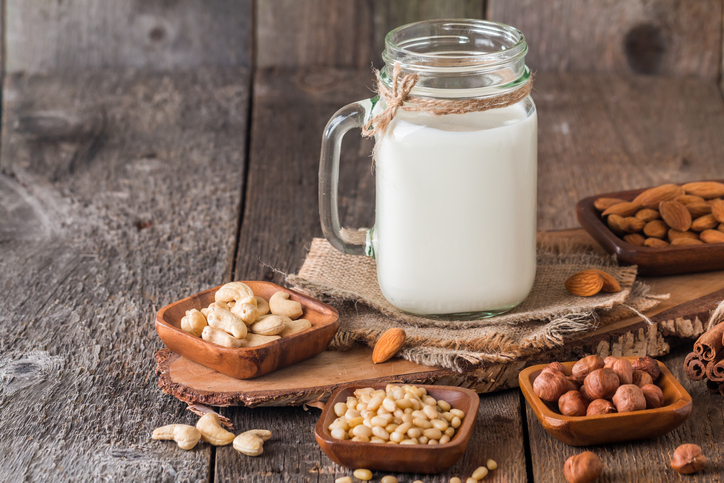Almond vs. Cow’s Milk—Which Is the Best Milk to Drink?

Q: I’ve drank cow’s milk all my life. I even remember drinking it fresh from the cow when I was a little kid. Now, I’m seeing all types of different milks in the grocery store. Is there any real reason to use almond milk instead of fat-free cow’s milk? When it comes to fat loss and getting rid of belly fat, which one is really best?
-Linda
A: Thank you for your fantastic question, Linda! There are so many choices when it comes to milk—from rice to hemp to almond to cow’s. But let’s take a closer look at perhaps the two most popular options (almond vs. skim milk) and get right to the point.
What’s the Best Milk to Drink
Cup for cup, unsweetened almond milk seems to be the best milk to drink over much of the commercially available milk, including cow milk. Here’s why…
At only 30 calories per serving, unsweetened almond milk contains less than half the calories of a glass of skim milk.
Unsweetened almond milk is naturally sugar-free. On top of that, a serving of unsweetened almond milk even boasts 1 gram of fiber. On the contrary, a glass of skim milk contains 12 grams of sugar, most of which is lactose.
This is important since over 33% of the United States population is lactose intolerant. What does it mean to be lactose intolerant? Simply, the body doesn’t produce enough of the enzyme lactase to break down this difficult-to-digest dairy-based carbohydrate. Symptoms typically appear within 20 minutes to 2 hours of ingestion and most commonly include stomach pain, gas, bloating, cramping, diarrhea, nausea, and even vomiting. Not fun!
You might be asking, “What about calcium?” That’s another great question because of the importance of calcium for bone health. Interestingly, a serving of almond milk actually contains 50% more calcium than skim milk! A cup of unsweetened almond milk boasts 45% of the recommended daily value of calcium whereas a glass of skim milk provides 30%.
That’s two points for almond milk being the best milk to drink.
Dietary calcium does more than just build bones. As a matter of fact, it’s directly related to sleep cycles. According to one study, calcium levels in the body are higher during some of the deepest levels of sleep, such as the REM (rapid eye movement) phase. The study concluded that disturbances in sleep, especially the absence of REM deep sleep or disturbed REM sleep, are related to a calcium deficiency. Restoration to the normal course of sleep was achieved following the normalization of the blood calcium level. Maybe having that warm glass of milk—cow’s or especially almond!—before bed really does have some merit.
Another benefit for almond milk being the best milk to drink is the fact that it is loaded with Vitamin D, providing 25% of your daily requirements for the “sunshine vitamin.” Almond milk is also an excellent source of Vitamin E, yielding 50% of the recommended daily value in a single serving. According to the USDA, 86% of the United States population fails to meet the RDA for this antioxidant powerhouse, and a cup of skim milk does little to help, as it contains virtually no Vitamin E.
Almond milk also contains 3 grams of fat—about 2/3 of that is the monounsaturated variety. Monounsaturated fats, which are also plentiful in olives, olive oil, avocados, nuts, and seeds, are typically known for being “heart healthy.”
In addition to cardiovascular benefits, recent research from the American Journal of Clinical Nutrition suggests that monounsaturated fats boost the metabolism by increasing resting energy expenditure and physical activity. What’s more, the researchers noted that participants who consumed more monounsaturated fats were in a better mood to boot!
Thus, after we tally up all these results, it’s pretty easy to conclude that making the switch from skim milk to almond milk can help burn belly fat and augment health and vitality.
As usual, however, it’s a great idea to check the label as the overwhelming majority of store-bought versions do have added stabilizers, preservatives, thickeners, flavors, etc. In an “ideal” situation, the best version of almond milk would likely only contain (filtered) water and almonds.
And arguably, the best milk to drink would be one made at home. To make, you take one cup of almonds and soak them overnight (preferably at least 12 hours in filtered water with a pinch of sea salt). Rinse your almonds well and then place the soaked almonds in a blender with 4 cups of filtered water. Then just blend—it does take several minutes—until it’s smooth and creamy. Then strain the mixture. Your milk can easily be stored in a glass jar or pitcher in the fridge for up to a week.
Or, if time doesn’t allow for you to make it yourself, you can also find better store-bought versions that list almond milk (i.e., filtered water and almonds) as their first ingredients.
Either way, you’ll find almond milk is tasty, healthy, and works great in your favorite BioTRUST smoothie!
BioTrust Low Carb Protein for Your Smoothie.
==>Get Up to 20% Off Now (Limited Time).
I hope this helps!
-Coach Joel






